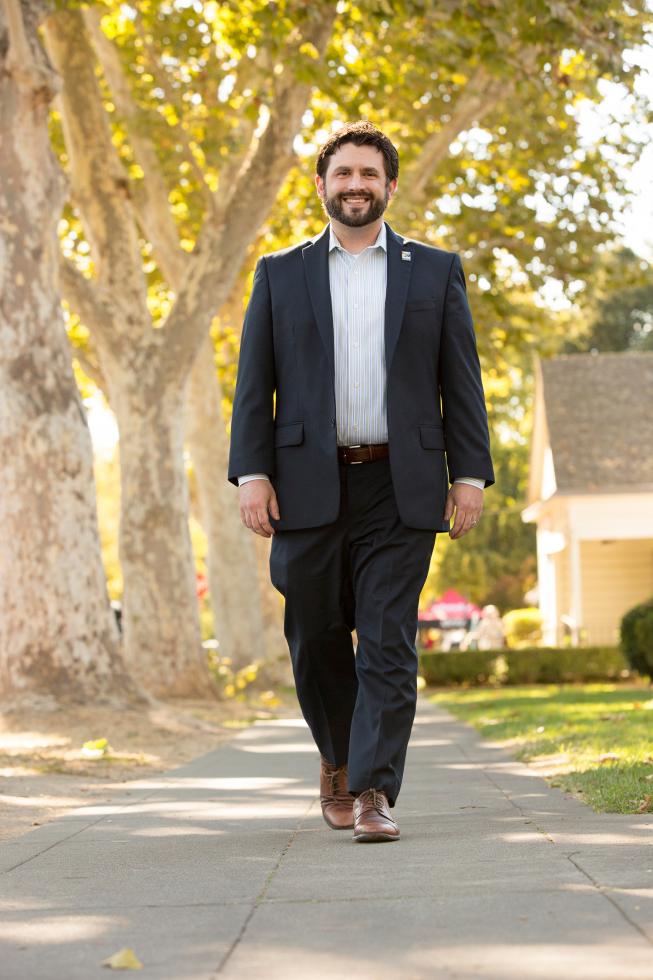Matt Yancey has been selected as the new CEO of the Davis Chamber of Commerce after serving more than seven years as the director of business and economic development at the Sacramento Metro Chamber. So how do you grow a city that’s been historically anti-growth?
In our September opinion column, UC Davis Chancellor Linda Katehi suggested UC Davis, not Sacramento, is the epicenter of the region’s economy, as it’s the primary generator of innovation and new companies. What is your perspective on UC Davis’s position in the region’s economy?
It’s a powerhouse in terms of research and its capacity to commercialize that research into new products, services and business. Then you’ve got the UC Davis Health System; there are discussions of the World Food Center and where that’s going to land. It’s a significant asset, and when we’re talking about innovation, that’s the focal point. But for a long time, Davis had a very specific reputation from the outside of the region — the politics of the community and the degree to which the region perceived Davis’s desire to grow. But people are starting to view Davis differently than they have in the past, and Davis is starting to recognize that economic development isn’t cookie-cutter. It doesn’t have to just be about putting up subdivisions and new buildings. You can integrate economic development with the atmosphere you want in your community.
Last year, the Davis Chamber released a report noting a 3,000-job deficit in the city. In order to improve job creation, the Innovation and Economic Vitality Work Program was created. It calls, in part, for an expanded support network for local businesses. What elements need to be augmented?
Davis has a lot of services available to businesses, accessible through the city or through Davis Roots or Tech Davis. There’s a lot of stuff out there. The challenge is helping business owners make connections to those services. It’s a matter of having network infrastructure in place to make sure you’re connecting businesses that have a need with the proper service provider.
What are the appropriate metrics by which to judge an economic develop ment organization? How should we measure your success?
Job creation and retention is the big metric. Are we creating more wealth? The chief challenge for economic developers is that, by and large, we don’t directly create jobs. In terms of genuine, high-volume job creation, that happens in the private sector. So there is an indirect relationship between what we do and the companies creating the jobs. We have performance metrics based upon the work programs we believe will lead to job creation. Metrics are set to measure whether we hit the marks we said we’d hit, and then you look at job creation, business revenue and the number of businesses as benchmarks for whether the program provided the projected results. If yes, fantastic. If no, why not? What do we need to adjust?
When you set out to bring in knowledge-based companies and industries, as Davis has, how does your strategy differ from attracting retail, tourism or manufacturing, for example?
Incubators are one way to go after those companies. We also have to put a focus on ensuring a connection between researchers and entrepreneurs and MBA students and folks with business degrees. It’s about building that team and making sure the network is in place. So if you’re sitting across from a Ph.D. chemist who doesn’t have experience on the business side, if there’s a way to connect that technical expertise with business acumen, you can grow a company.
Davis’s vacant commercial land inventory is limited, creating both immediate and long-range challenges for business growth. How do space limitations play into your strategy as you seek to draw in new companies and industries?
Lack of available developed commercial property is not just a factor in your ability to attract new businesses to your community, it’s also a factor in the degree to which you grow businesses. It’s a particular challenge in a community like Davis, which is tied to a university where you have so much innovation and so many businesses being formed. Is there enough space to retain them past a certain threshold? That is one of the key factors driving the conversations around the innovation park proposals. Is there a model that fits for Davis to increase the capacity of the space available to retain and grow — and, in some cases, launch — those companies? We think the potential of the innovation park concept (like a business park for startups) could be huge. Now the questions surround what the actual project proposals look like and whether they match up to the potential economic benefit and the fabric of the community.
Recommended For You

Green Grids
Transportation reforms throughout the region are changing the ways people live and travel in Yolo County
It’s been a year since Gov. Jerry Brown signed legislation that created the Active Transportation Program to boost non-motorized transportation across the state, where one in four Californians are obese and more than 3.9 million are diabetic. And as California emerges as a national leader in transportation reform, Yolo County is finding itself at the forefront of the movement.

Growth and Prosperity
UC Davis is the keystone to the Capital Region’s economic success
In civic and business circles, we often hear the lament that Sacramento has never been a corporate headquarters. Many believe this hampers our ability to fully prosper and grow. But, in addition to the attractive traits Sacramento does possess, it has a powerful economic catalyst in its backyard: a top-10 public research university that can be the lifeblood of a stronger, deeper and more resilient regional economy.

Brain-Powered Bionics
How technology is using mind control to help people walk again
There are 6 million people in the United States who are paralyzed. Wide-spread, thought-controlled medical solutions won’t be available tomorrow or next month or even next year. But what if, some day, all of those people could walk again?

#YOLO
The 7 best bike rides in Yolo County
Lovely scenery along gently rolling foothills has always made Yolo County an ideal place for cyclists, but who knew everyone took it so seriously?



